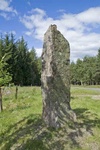| Birse War Memorial |
|---|

It is a solid tapering rectangular obelisk of rough hewn coursed granite blocks with the lettering carved into them in dressed bands. There is a small roundel with inset curved cross. The top is a stepped pyramidal shape. It has the same 'arts and crafts feel' as the Battle of Harlaw Memorial Monument by the same designer. More Information |
| Corsearder, Corsedarder or Corsedardar Stone |

A squarish block of reddish granite, about 4'7" in maximum height and 7' in girth, which was dug up many years before 1842 and was erected on top of the hill of Corsedardar, in the belief that it had marked the grave of some eminent person. The stone has been split, and now has the two portions set into a bed of concrete and pieced together by strong iron bands. Tradition says that it marks the spot where Dardanus, a Pictish king, was killed. A stone, 1.5m high, 0.8m wide, and 0.2m thick, generally as described, and possibly a cist slab. Visited by OS (R L) 12 June 1972. from RCAHMS |
| Corsedardar Long Cairn |

Remains of cairn; a curving scarp in the E probably represents the edge of the cairn in this quadrant; otherwise all that can be seen is turf-covered debris, insufficient to estimate the size and shape of the cairn. Part of it was dug into in c1860 when human remains and several silver coins were found. More Information |
| Millennium Stone |

Dedicated on 1st January 2000 with nearly 300 people from local communities of Finzean, Ballogie and Birse in attendance. Anointed with waters from the boundary rivers of the community. The stone came from Craig of Woodend, near the Finzean quarry that was the source of the Birse War Memorial stones, stone donated by the Farquarsons of Finzean estate. More Information |
This content was submitted by external contributors and does not necessarily reflect the views of the University of Aberdeen.
